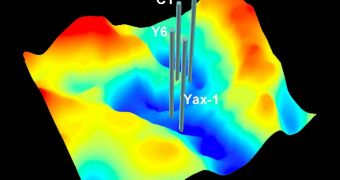Establishing what killed the dinosaurs is something the international scientific community has been trying to do for decades. A large number of theories on this issue have been published, rebutted and considered, but a clear consensus has yet to be achieved. Numerous scientists have rallied themselves to various points of view, and have been arguing against each other for many years. Now, a comprehensive, global study that takes into account most factors that were at play during the last extinction event comes to settle the dispute once and for all.
Many studies have in the past linked the extinction of the dinosaurs – among countless other species – with a giant impact from a space rock. This event, thought to have taken place around 65 million years ago, at the Cretaceous-Paleogene (K-Pg) boundary, was documented in many instances. But over the past few years a lot of researchers have begun arguing that other factors may have played an equally-significant part, such as for example ongoing volcanic eruptions, which covered the skies with ashes, and brought forth very cold temperatures. Some have even argued that the asteroid impact may have taken place about 300,000 years before the extinction event itself.
In a new paper, published in the March 5 issue of the top journal Science, a team of 41 scientists from 12 nations shows that this was not the case. In a research effort sponsored in part by the US National Science Foundation (NSF), the investigators determined that the theories such as the dual-impact one are unfounded. They provide the first batch of clear evidence that the impactor which struck in Chicxulub, Mexico, is the main culprit behind the K-Pg extinction. The investigation is in fact a comprehensive review of the multiple, global lines of evidence that were uncovered until now.
“We felt it important to present the wealth of data now available about the remarkable and exact correlation between the impact in the Yucatan and the extinction event at the K-Pg boundary,” says Sean Gulick, who is a geophysicist at the University of Texas, and also an author of the study. The team was led by University of Erlangen-Nuremburg expert Peter Schulte. The group reveals that proof to support their claims can be found even in the ocean floor, especially in sediment layer samples.
“The impact event triggered tsunami many times the size of the wave that hit the Indian Ocean on Dec. 26, 2004. These waves caused massive destruction on the sea floor, with the multiple sediment layers representing the deposition of impact-derived material, mixed with sand and silt, by waves and currents over periods of days after the impact. As the energy levels gradually decreased, the materials settling down gradually became finer,” explains Penn State University marine geologist Tim Bralower.
“The Chicxulub impact was an extremely rapid perturbation of the Earth's ecosystems, at a scale greater than that of any single volcanic event at the time, or of any other impact known since life became prevalent on Earth. The rate of change and scale of the effects were clearly the cause of the mass extinction at the end of the Cretaceous,” Gulick concludes.

 14 DAY TRIAL //
14 DAY TRIAL //